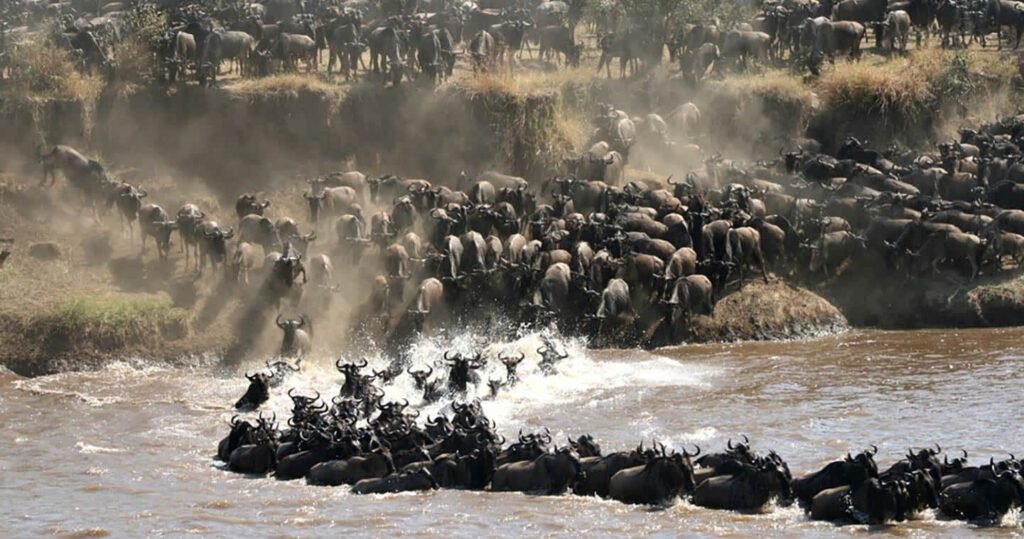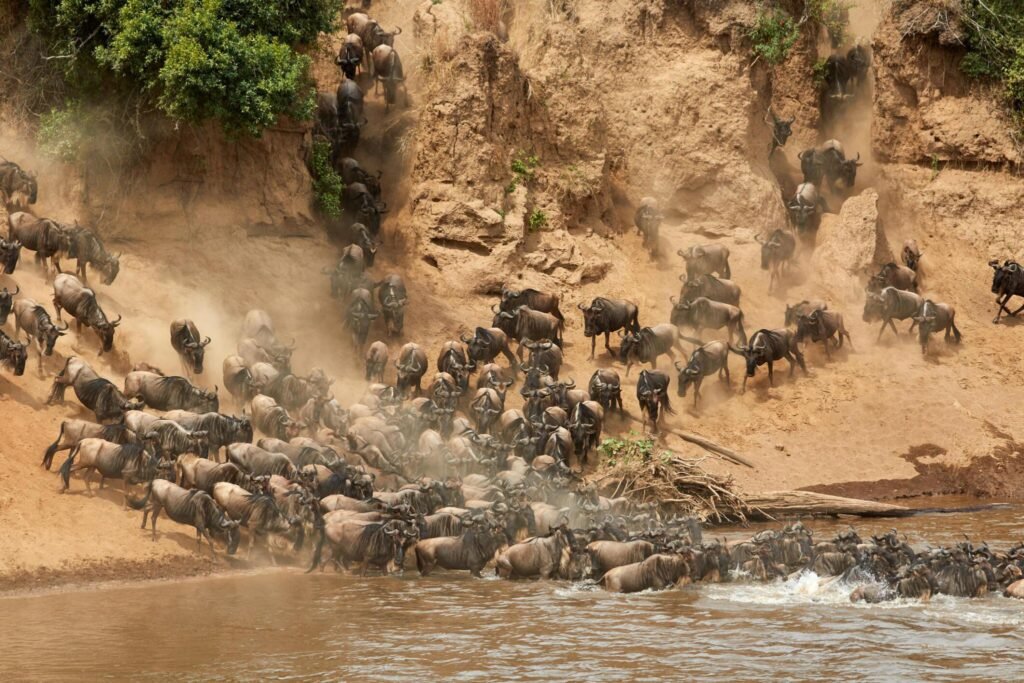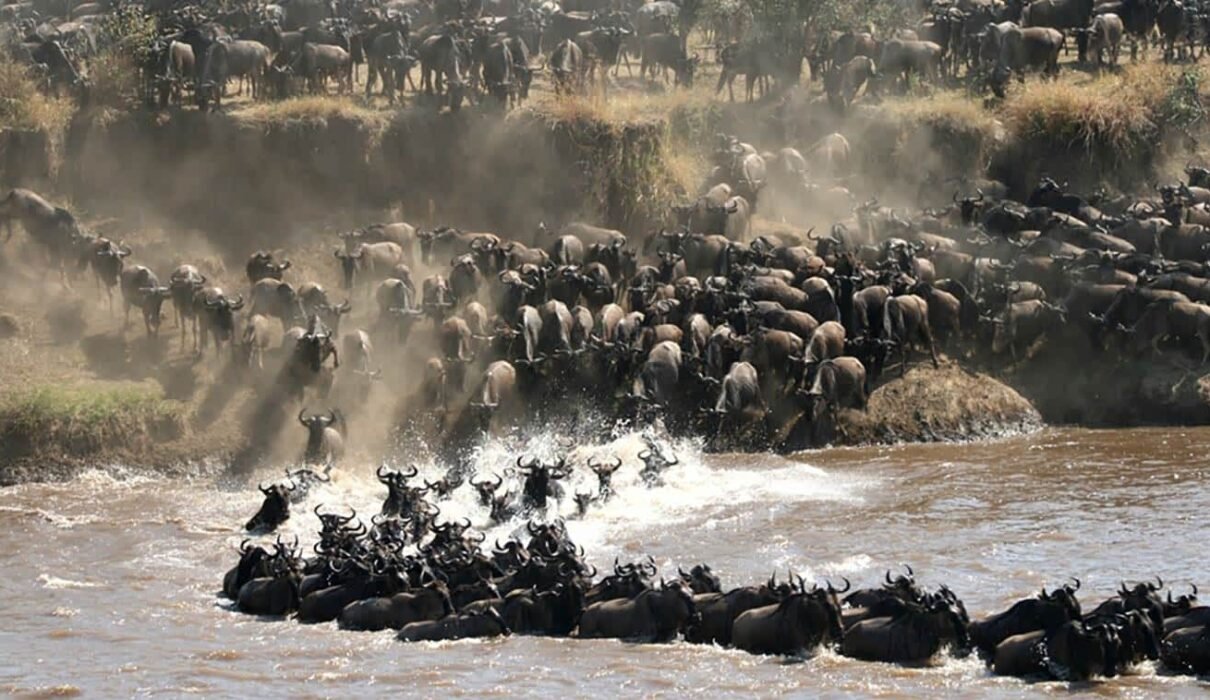Tips for Planning Your Wildebeest Migration Safari : The Great Migration is one of the most spectacular wildlife events in the world, where over 1.5 million wildebeest, along with hundreds of thousands of zebras and gazelles, migrate across the plains of the Serengeti in Tanzania to the Maasai Mara in Kenya. Planning a safari to witness this breathtaking natural phenomenon requires careful consideration to ensure you’re in the right place at the right time.
In this guide, we’ll cover essential tips for planning your wildebeest migration safari, from choosing the best time to visit to selecting the perfect accommodations.

Tips for Planning Your Wildebeest Migration Safari : Understand the Migration Phases
The Great Migration is a continuous, year-round movement of animals across the Serengeti-Maasai Mara ecosystem. To maximize your experience, it’s important to understand the different phases of the migration and the best times to see them.
Migration Timeline:
- January to March: This is calving season in the southern Serengeti and Ndutu Plains, where thousands of wildebeest calves are born. This period offers great predator-prey interaction as lions, cheetahs, and hyenas hunt the newborns.
- April to June: The herds begin moving north toward the Grumeti River, making this a good time to witness the herds crossing rivers and covering large distances.
- July to October: The most dramatic event, the river crossings, happen during this time as the herds cross the Grumeti and Mara Rivers. It’s one of the most sought-after moments to witness, but also one of the busiest times for tourists.
- November to December: The herds begin their journey south again, moving through the eastern Serengeti as they return to the calving grounds.
Learn more about the migration timeline with Kilimanjaro Climb Specialist
Tips for Planning Your Wildebeest Migration Safari : Best Time to Visit for the Wildebeest Migration
While the migration is a year-round event, different times of the year offer distinct experiences. The best time to visit will depend on what phase of the migration you want to see.
Optimal Viewing Periods:
- Calving Season (January to March): Ideal for those wanting to see baby wildebeest and predator action. It’s also a quieter time, with fewer tourists.
- River Crossings (July to October): If witnessing the dramatic river crossings is your priority, this is the best time to visit. Keep in mind that it’s peak season, so advance booking is essential.
- November to December: As the herds head south, the migration is still active, and you’ll find fewer tourists, making this a great time for a more intimate safari experience.
Find the best time for your wildebeest safari with Eddy Tours Safaris
Tips for Planning Your Wildebeest Migration Safari : Choose the Right Safari Location
The Serengeti is vast, and the herds are constantly on the move, so choosing the right location to stay is crucial. Each area offers different advantages depending on the time of year and what part of the migration you want to witness.
Top Locations for the Great Migration:
- Southern Serengeti (Ndutu Plains): Best for calving season (January to March), when wildebeest give birth and predators are on the prowl.
- Western Corridor: Ideal from April to June as the herds make their way towards the Grumeti River.
- Northern Serengeti: Perfect for river crossings from July to October when the wildebeest cross the Mara River into Kenya.
- Central Serengeti: A great base year-round, offering consistent wildlife sightings and easy access to various parts of the Serengeti.
Discover more about the Serengeti’s regions and where to stay
Tips for Planning Your Wildebeest Migration Safari : Book the Right Safari Lodge or Camp
Accommodation plays a major role in the quality of your safari experience. Choosing a lodge or camp located near the migration paths can ensure you don’t miss any of the action.
Types of Accommodation:
- Luxury Tented Camps: These camps move seasonally to follow the migration and offer an immersive experience with close-up views of wildlife, luxurious amenities, and personalized service.
- Luxury Lodges: Offering more permanent accommodations, luxury lodges provide top-notch amenities like private verandas, pools, and gourmet dining.
- Mobile Camps: For those who want to be closer to the action, mobile camps move with the herds and offer a more flexible and adventurous safari experience.
Make sure to book your accommodation well in advance, especially if you’re traveling during peak migration times.
Find top safari lodges and camps with Kilimanjaro Climb Specialist
Tips for Planning Your Wildebeest Migration Safari : Consider Private Game Drives for a Personalized Experience
Private game drives are a great way to get the most out of your wildebeest migration safari. By opting for a private guide and vehicle, you can tailor the experience to your preferences, ensuring you get to see the wildlife and migration events that interest you most.
Benefits of Private Game Drives:
- Flexibility: You can decide when and where to go, allowing for longer or shorter game drives as you prefer.
- Exclusive Wildlife Viewing: With fewer vehicles around, you can enjoy uninterrupted views of the animals.
- Expert Guides: Private guides have extensive knowledge of the migration and can take you to prime viewing spots.
For an even more intimate experience, consider booking a walking safari or hot air balloon safari to witness the migration from a different perspective.
Explore private game drives in Tanzania
Tips for Planning Your Wildebeest Migration Safari : Pack the Right Gear for Your Migration Safari
Packing the right gear is essential to making the most of your migration safari. You’ll need to be prepared for varying weather conditions, long game drives, and plenty of time outdoors.
Essential Items to Pack:
- Neutral-Colored Clothing: Wear neutral tones like khaki, green, or beige to blend in with the environment and avoid attracting animals’ attention. Opt for lightweight, breathable fabrics that are ideal for the hot days and cooler nights.
- Binoculars: A good pair of binoculars is essential for getting a close-up view of the wildlife, especially during river crossings when animals may be far away.
- Camera Gear: Bring a camera with a good zoom lens to capture action shots. If possible, bring extra batteries and memory cards.
- Sunscreen and Insect Repellent: Protect yourself from the sun and insects, particularly during evening game drives.
Check out a complete safari packing guide
Tips for Planning Your Wildebeest Migration Safari : Health and Safety Tips for the Great Migration Safari
While Tanzania is a safe safari destination, it’s important to be aware of health precautions and safety tips to ensure a smooth and enjoyable trip.
Key Health Considerations:
- Vaccinations: Check with your doctor about necessary vaccinations, such as yellow fever and malaria, especially if you’re traveling to the Serengeti.
- Travel Insurance: Purchase comprehensive travel insurance that covers medical emergencies, cancellations, and lost luggage.
- Insect Protection: Mosquitos can be prevalent in some areas, so pack mosquito repellent and wear long sleeves and pants in the evenings.
Being prepared with the right health and safety measures will ensure a worry-free experience on your migration safari.
Learn more about health and safety tips for African safaris
Tips for Planning Your Wildebeest Migration Safari : Plan for Photographic Opportunities
The wildebeest migration offers some of the best photographic opportunities in Africa. Whether you’re a professional photographer or an amateur with a passion for wildlife photography, the migration will provide endless opportunities for stunning shots.
Top Photography Tips:
- Golden Hour: Plan game drives during early morning or late afternoon, when the lighting is soft and wildlife is most active.
- River Crossings: If you’re photographing the river crossings, position yourself upstream to capture the action as the wildebeest enter the water.
- Patience is Key: Wildlife photography requires patience, so take your time and be ready to capture the unexpected.
Discover top wildlife photography tips for safaris
Tips for Planning Your Wildebeest Migration Safari : Budgeting for Your Migration Safari
The cost of a wildebeest migration safari can vary depending on factors such as the level of luxury, the length of your stay, and additional activities like hot air balloon rides.
Budget Considerations:
- Accommodation Costs: Luxury lodges and camps will be more expensive, especially during peak migration months. Budget travelers may want to consider mid-range camps or mobile camping options.
- Park Fees: Be sure to account for Serengeti National Park fees, which are typically included in your safari package but can add up depending on how many days you stay.
- Extra Activities: Hot air balloon safaris, night drives, and walking safaris come with additional costs, so plan accordingly.
By setting a clear budget, you can tailor your safari experience to meet your financial needs without sacrificing the quality of the trip.
Find budget-friendly safari packages with Eddy Tours Safaris

Tips for Planning Your Wildebeest Migration Safari : FAQs
1. When is the best time to witness the wildebeest river crossings?
The best time to see the river crossings is between July and October when the herds cross the Grumeti and Mara Rivers. This is a popular time, so be sure to book early.
2. How far in advance should I book my migration safari?
It’s recommended to book your migration safari at least 6 to 12 months in advance, especially if you’re traveling during peak migration times.
3. Can I combine a migration safari with other activities?
Yes! Many travelers combine a migration safari with trips to Zanzibar for beach relaxation or a trek up Mount Kilimanjaro for a complete Tanzanian adventure.
Start planning your wildebeest migration safari with Kilimanjaro Climb Specialist
Tips for Planning Your Wildebeest Migration Safari : Start Planning Your Wildebeest Migration Safari Today
Witnessing the Great Migration is a once-in-a-lifetime experience that offers unparalleled wildlife encounters, breathtaking landscapes, and unforgettable moments. By following these tips, you can ensure that your wildebeest migration safari is well-planned and tailored to your travel preferences.
Start planning your wildebeest migration safari with Kilimanjaro Climb Specialist
Book your next adventure with Eddy Tours Safaris

